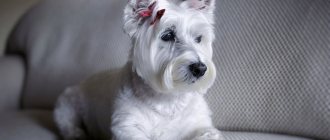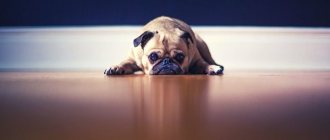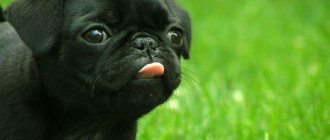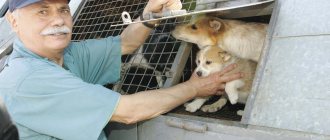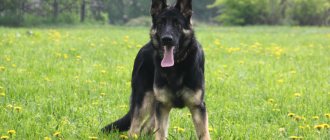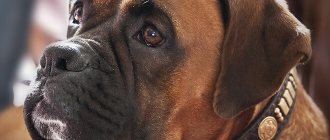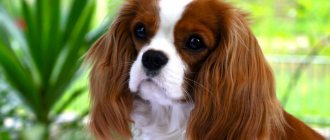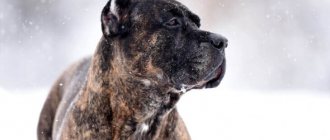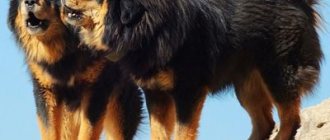History of the breed
The homeland of dogs is in Belgium, where they served as hunting dogs and were used to kill rodents. In addition, black dogs coped well with protecting the stingray and the owner’s property. Schipperke was first described in the 19th century.
This breed has a very interesting history. In the 14th century, a law was passed in Belgium that allowed only aristocrats to keep large dogs, but such a luxury was not permissible for ordinary people. The way out of this situation was to breed two types of shepherd dogs - large and small.
From Belgian territory, this law spread to other European countries. Accordingly, Schipperke began to gain popularity. Their recognition dates back to 1882; around the same time period, the breed was officially described and a standard was published.
Black dogs became very popular in England; the puppies brought to Foggy Albion made an indelible impression on the members of the royal dynasty, which is what made the Belgians very fashionable. The nobility did not pay much attention to the purebred of the dogs; for the aristocrats, only the black color, the lack of a tail in the puppy, and Belgian “citizenship” were important.
Disqualification
- Lack of breed type.
- Weight is not within acceptable limits.
- Drop or semi-erect ears.
- Lack of pigment on lips, nose, eyelids.
- Undershot or overshot, even without loss of contact (reverse scissors), misalignment of the jaws, lack of one canine (1 C), one upper fourth premolar (1PM4) or one lower carnassial (1M1), or one molar (1M1 or 1M2, but not M3), or one fourth premolar (lower PM4), or one third premolar (1PM3), as well as another tooth, or a total of four teeth or more (excluding the four first premolars).
- Very long, very soft or very silky coat (clearly long-haired type). Complete absence of undercoat. The fringes are formed from long and thin wool. Guard hair of any color other than black (except for markings of grey, brownish and reddish shades) or the presence of white spots, including on the fingers.
- Aggressive behavior or cowardice. The dog is showing obvious behavioral or physical abnormalities.
Note : Males must have two normally developed testes, fully descended into the scrotum.
- Schipperke tail
- How to choose a Schipperke puppy
- Schipperke health problems
Description of the breed, characteristics
Purebred dogs have a harmonious physique and thick coat. The body is tightly built with well-developed muscles. Despite the lightweight bones of the skeleton, the joints are well positioned. The muzzle is shortened and this feature makes Schipperkes have an attractive appearance. Males and females have differences in size and proportions.
Modern Belgians are considered companions, ideal for family life; in addition, dogs can serve as protectors. Representatives of this breed are cheerful, energetic and curious animals. They are constantly moving, interested in the world around them and enjoy exploring previously unknown places.
Such fidgets need frequent and long walks so that they can throw out excess energy. Otherwise, the Schipperke will begin to show increased activity, which consists of constantly spinning underfoot and getting attached to the pets. Belgians take great pleasure in traveling, and they really enjoy traveling by car, when the dog can admire the surrounding landscape through the window.
Representatives of this breed are able to spend a lot of time in outdoor games, and therefore Schipperkes are often found in families with children. True, adults will have to forget for a long time what peace and quiet is due to the noisy company.
Worth knowing. Belgian dogs are not the best option for those with very young children. Careless handling makes the pet extremely irritable.
Despite their small size, the dogs are very brave, fearless and strong. If the need arises, the animal will enter into a fight with an opponent of large size. It all comes down to education; if a dog is not trained correctly, it becomes a real problem. Schipperkes can become aggressive even to their owners.
Belgians are famous for their vigilance; they do not miss a single extraneous sound, and notify about them with a loud bark. This behavioral feature causes trouble for both the owner and others, which means it needs to be corrected. Trained dogs quickly fall silent as soon as they are given a specific command.
How to choose a puppy
Choosing a puppy is a difficult and responsible moment. Initially, a person determines whether a Schipperke dog is suitable for him. If you lack free time, it is better to abandon the acquisition idea. Active, playful by nature, the Schipperke puppy requires a lot of attention, time for exercise and training. If the owner comes home late in the evening and leaves early in the morning, then the dog will grow up withdrawn and aggressive when alone. Also, if a person likes to spend his free time on the couch in front of the TV, then it’s worth looking for a calmer companion.
To buy a puppy, it is better to turn to professionals, experienced breeders. Here they will give advice on caring for and raising your baby. A reputable breeder will be happy to demonstrate the living conditions of the puppies and the bitch, boast about the achievements of the Schipperke dog, take photos of puppies from other litters, and tell everything about the breed.
The puppy's parents must be tested for the genetic disease mucopolysaccharidosis. If the mother or father does not have the test result, it is better to refuse the purchase.
Breed standard
Each breed has certain requirements regarding appearance, and the Schipperke is no exception. You can see the approved measurements in the table below.
Breed standard
| Parameter name | Description |
| Head | It has the shape of a shortened wedge. The muzzle is neat, tapering towards the nose. The frontal lobe is wide, the lips are dense. The eyes are almond-shaped and have brown irises. |
| Teeth | Dogs have a regular straight bite. Individuals with an incomplete set of teeth are not non-standard, so a Schipperke may lack a third molar and second premolars |
| Ears | Small in size, vertical, flexible, with a pointed tip |
| Torso | Has the shape of a square. The cervical region is of medium length, quite wide. The chest is tightly built and dropped down. The dorsal region is wide, short, the withers are well developed, the back flows into the lower back, the croup is rounded |
| Paws | Powerful, hind limbs longer than forelimbs |
| Tail | There are tailless individuals (deprived of it from birth), and it can also be docked briefly or left in the form in which it is. The tail may curl strongly, this is not a flaw |
Description and appearance of Schipperke
With a decorative appearance and small size, the dog has a strong physique and well-developed muscles.
The skeleton is lightweight, but the joints are firmly set. The body is square, the neck is of medium length, and due to the voluminous fur it looks powerful. The chest is round, the withers are pronounced, the back is wide and short. Limbs are strong and proportional. The hands are arched, the fingers have curved, thick claws. The head is wedge-shaped and visually appears shortened. The forehead is of medium width, without unnecessary convexity, with a smooth stop. The muzzle is narrowed and neat. The bridge of the nose is straight, the nose is small and black. The eyes are almond-shaped, brown, with an attentive expression. The jaw is strong and has a scissor bite. The ears are small, triangular, with pointed ends, located vertically. The tail can be curled, thrown over the back, hanging calmly; sometimes puppies are born without tails, which is not considered a defect. The coat is thick, hard, and has a soft, dense undercoat. The fur on the neck forms a kind of mane, turning into a frill. The color is plain, black. A male differs from a female in size and proportionality.
The purebred representative has a height of 25-33 cm, weight - 3-9 kg. Miniature dogs are excluded from breeding, and heavy dogs are not highly appreciated at shows.
Take the Attention Test! Find 10 differences! (click right here!)
Find the answer Are you bothered by some problem or question? Enter “Breed” or “Name of the problem” into the form, press Enter and you will find out everything about the issue that interests you.
With proper care for your pet, life expectancy can be 15 years or more.
You can get acquainted with the breed standard at dog shows, where professional breeders demonstrate exemplary dogs.
Advantages and disadvantages of Schipperke
The most positive quality of representatives of this breed is very good health and unpretentiousness to living conditions. Belgians do not need comfort; keeping them in an enclosure is also suitable, where the dogs will not freeze because they have a thick undercoat.
Quick learning is another positive feature of shepherd dogs, which also includes being owner-oriented. Dogs are working dogs, and therefore the owner will need to realize the natural qualities of the pets; if this condition is met, then the Schipperke will make an excellent companion.
If we talk about the disadvantages, many cite a very high price that will have to be paid for a representative of this breed. Another disadvantage is the need for the owner to spend a lot of time with his pet when it is undergoing psychological stabilization. This period occurs between 21 and 105 days of age.
Excerpt characterizing Schipperke
- Well, are you bored here? asked Pierre. - It’s not boring, falcon. Call me Plato; Karataev’s nickname,” he added, apparently in order to make it easier for Pierre to address him. - They called him Falcon in the service. How not to be bored, falcon! Moscow, she is the mother of cities. How not to get bored looking at this. Yes, the worm gnaws at the cabbage, but before that you disappear: that’s what the old men used to say,” he added quickly. - How, how did you say that? asked Pierre. - Is that me? – asked Karataev. “I say: not by our mind, but by God’s judgment,” he said, thinking that he was repeating what had been said. And he immediately continued: “How come you, master, have estates?” And there is a house? Therefore, the cup is full! And is there a hostess? Are your old parents still alive? - he asked, and although Pierre could not see in the darkness, he felt that the soldier’s lips were wrinkled with a restrained smile of affection while he was asking this. He was apparently upset that Pierre did not have parents, especially a mother. “A wife is for advice, a mother-in-law is for greetings, and nothing is dearer than your own mother!” - he said. - Well, are there any children? – he continued to ask. Pierre's negative answer again apparently upset him, and he hastened to add: “Well, there will be young people, God willing.” If only I could live in the council... “It doesn’t matter now,” Pierre said involuntarily. “Eh, you’re a dear man,” Plato objected. - Never give up money or prison. “He sat down better and cleared his throat, apparently preparing for a long story. “So, my dear friend, I was still living at home,” he began. “Our patrimony is rich, there is a lot of land, the men live well, and our home, thank God.” The priest himself went out to mow. We lived well. They were real Christians. It happened... - And Platon Karataev told a long story about how he went to someone else’s grove behind the forest and was caught by a guard, how he was whipped, tried and handed over to the soldiers. “Well, the falcon,” he said, his voice changing with a smile, “they thought grief, but joy!” My brother should go, if it were not for my sin. And the younger brother has five boys himself - and look, I have only one soldier left. There was a girl, and God took care of her even before she became a soldier. I came on leave, I’ll tell you. I see they live better than before. The yard is full of bellies, women are at home, two brothers are at work. Only Mikhailo, the youngest, is at home. Father says: “All children are equal to me: no matter what finger you bite, everything hurts. If only Plato hadn’t been shaved then, Mikhail would have gone.” He called us all - believe me - he put us in front of the image. Mikhailo, he says, come here, bow at his feet, and you, woman, bow, and your grandchildren bow. Got it? speaks. So, my dear friend. Rock is looking for his head. And we judge everything: sometimes it’s not good, sometimes it’s not okay. Our happiness, my friend, is like water in delirium: if you pull it, it swells, but if you pull it out, there’s nothing. So that. - And Plato sat down on his straw. After being silent for some time, Plato stood up. - Well, I have tea, do you want to sleep? - he said and quickly began to cross himself, saying: “Lord, Jesus Christ, St. Nicholas, Frol and Lavra, Lord Jesus Christ, St. Nicholas!” Frol and Lavra, Lord Jesus Christ - have mercy and save us! - he concluded, bowed to the ground, stood up and, sighing, sat down on his straw. - That's it. “Put it down, God, like a pebble, lift it up like a ball,” he said and lay down, pulling on his greatcoat. -What prayer were you reading? – asked Pierre. - Ass? - said Plato (he was already falling asleep). - Read what? I prayed to God. Don’t you ever pray? “No, and I pray,” said Pierre. - But what did you say: Frol and Lavra? “But what about,” Plato quickly answered, “a horse festival.” And we must feel sorry for the livestock,” Karataev said. - Look, the rogue has curled up. She got warm, the son of a bitch,” he said, feeling the dog at his feet, and, turning around again, immediately fell asleep. Outside, crying and screams could be heard somewhere in the distance, and fire could be seen through the cracks of the booth; but in the booth it was quiet and dark. Pierre did not sleep for a long time and, with open eyes, lay in his place in the darkness, listening to the measured snoring of Plato, who lay next to him, and felt that the previously destroyed world was now being erected in his soul with new beauty, on some new and unshakable foundations. In the booth into which Pierre entered and in which he stayed for four weeks, there were twenty-three captured soldiers, three officers and two officials. All of them then appeared to Pierre as if in a fog, but Platon Karataev remained forever in Pierre’s soul as the strongest and dearest memory and personification of everything Russian, kind and round. When the next day, at dawn, Pierre saw his neighbor, the first impression of something round was completely confirmed: the whole figure of Plato in his French overcoat belted with a rope, in a cap and bast shoes, was round, his head was completely round, his back, chest, shoulders, even the hands that he carried, as if always about to hug something, were round; a pleasant smile and large brown gentle eyes were round.
Maintenance and care
The potential owner of a Belgian should remember that the coat of black dogs requires constant care. Schipperkes shed three times a year for 10 days. Despite the fact that the time period is not that long, the owner will have to comb his pet every day. Grooming and trimming are not used for dogs of this breed.
Good to know. Shepherd dogs from Belgium are rarely bathed. Dogs love snow very much, and therefore clean their coats themselves using snowdrifts for this purpose. On a hot summer day, your four-legged pet will not without pleasure climb into a pond to swim. Dogs are bathed purposefully if there is an emergency need for this.
Belgians' teeth are quite strong, and therefore the oral cavity is examined once a month to prevent the formation of plaque. Ears and eyes need more attention. If lacrimation occurs (a rather rare occurrence), a special ophthalmic rinsing solution is used. Ears should be cleaned once a week.
Mandatory care for the Schipperke also includes keeping the dog in good physical shape. This will require long walks and a balanced diet. Belgians do not complain about their appetite, and can eat anything edible that comes their way.
Diseases inherent in the breed
Schipperke owners rarely complain that their pets are in poor health. Mucopolysaccharidosis can be inherited from dogs, but animals rarely suffer from the disease. The pathology occurs due to a genetic mutation and cannot be treated. Sometimes a Schipperke is diagnosed with:
- hypothyroidism;
- necrosis of the femoral head;
- allergies;
- epilepsy.
DNA testing, which is carried out before mating breeding stock, helps reduce the risk of developing diseases in a small shepherd dog. Carriers of the mutated gene do not suffer from mucopolysaccharidosis.
The Schipperke is a beautiful miniature dog with black shiny fur the size of a decorative Spitz. An active and brave dog, similar in character to a German shepherd, becomes a friend to its owner and is able to give his life for him.
Feeding
For representatives of this breed, feeding with both factory-made feed and natural products is suitable. In the latter case, you need to remember that the food must be balanced. This point is important not only for puppies, but also for adult dogs.
When choosing among brands of dry food, preference should be given to super-premium or premium class designed for dogs leading an active lifestyle and belonging to medium breeds. As for the amount of food per day, manufacturers calculated it long ago and put it in a table, which should be on the back of the package.
If natural feeding is used, the dog must receive the following products:
- beef;
- cereals;
- fermented milk products;
- vegetable and fruit crops.
Meat should account for at least 1/3 of the total diet. It is recommended to give vegetables and fruits to animals fed both natural and factory feed.
Features of feeding and diet
When a puppy appears in the house, the owner needs to create a diet and diet, since if the Schipperke is not fed correctly, the dog will lose its shape. Nutrition can be provided with both natural and industrial food, but only the dog product must be super-premium class.
With natural food, it is necessary to choose exclusively fresh products: lean meats, cereals, vegetables, fruits.
As for the regime, it is composed as follows:
- up to 2 months – 6 times a day;
- from 2 to 4 months – 5 times a day;
- from 4 to 6 months – 4 times a day;
- from 6 to 8 months – 3 times a day;
- from 9 months – 2 times, morning and evening.
Upbringing
Belgian dogs require consistent training, which should begin from puppyhood. Schipperkes are distinguished by the fact that they quickly lose interest in training. If, over the course of several days, they are forced to learn the same command, the dog will very quickly stop following it.
The essence of education is to force the animal to perform the functions that are inherent in it by nature. The main aspect here is weaning off incessant barking, which is quite a difficult task. The Belgian should bark to notify about the visit of a stranger, but not react in this way to the arrival of guests already familiar to him.
When a puppy arrives at a new place of residence, it is necessary to begin the educational process with him. He needs to be taught to do his business in a diaper until the end of quarantine after vaccinations. Then the dog is taught to relieve itself while walking. Belgian Shepherds have a certain thirst for knowledge, but the main characteristic here is the ability to please the owner. During classes, a trusting relationship must be established between the owner and the pet.
According to the observations of dog handlers, the best training for representatives of this breed are courses such as:
- agility;
- flyball;
- international obedience course.
It is recommended that the dog undergo OCD, which begins at the age of six or eight months. Before starting training with a professional instructor, the owner will have to teach the pet the most common commands. Schipperkes are a late-developing breed and can be considered adults from the age of 3 to 4 years.
Character
In its playfulness, loyalty and friendly disposition, the Schipperke is similar to dog breeds such as the Pomeranian and German Spitz. But one cannot call him irresponsible; he has a harmonious sense of duty (security, watchdog qualities) and a love for various entertainments.
The little dog, of course, will not be able to cope with the robber on his own, but he will be able to warn his owners about the arrival of uninvited guests with a loud bark. He always treats strangers with distrust and watches their actions warily. Noticing a threat in the movements of a stranger, the Schipperke will immediately rush to protect the owner and all household members. Able to bite in a dangerous situation.
Representatives of the breed get along with children from their family, but with insufficient education they can react poorly to other people's children and their pranks.
Curiosity and activity are integral features of the Schipperke. This nimble dog seemingly never sits still for a minute. He constantly studies the territory and is interested in the world around him. It reacts to any moving object with a loud bark and raised scruff. This is not surprising, because the instinct of a rodent hunter has been in full swing in this dog since birth. Rest assured that there will not be a single mouse or rat in the territory under the Schipper’s control.
Representatives of the Belgian breed get along well with other pets. Schipperke is able to establish friendly relations even with a cat. But conflicts often arise with a dog of the same sex, which is explained by the struggle for leadership. It is not recommended to keep guinea pigs, ferrets, rats and other rodents in the same house as a Schipperke; a dog with a hunting instinct may mistake them for prey.
Parenting mistakes
The most common shortcoming in Schipperke training is considered to be late socialization. Such dogs fully demonstrate their stubborn character and can begin to show aggression towards the owner and members of his family. An ill-mannered Belgian often raises his voice at a time when there is no need for it. Constant barking bothers not only the owners, but also the neighbors, which leads to conflict situations.
Education and training
Schipperkes are very smart, intelligent and quite easy to train. From early childhood, a puppy should not be overly pampered; all family members should participate in the upbringing and socialization of the dog, which will allow it to learn socially acceptable manners.
In terms of education and training, the Schipperke is a rather difficult dog for an inexperienced owner. Consultation or assistance from a professional dog handler may be required.
Raising a puppy begins literally from the moment it arrives in the house. The owner must be firm and consistent, and in no case harsh. The baby is praised for good behavior and correct reactions, and gently scolded for disobedience and pranks. From the age of 2 months, you can teach your dog basic commands: “come”, “sit”, “place”. By six months, puppies that have not been trained become very stubborn, and it will be very difficult to train or correct their behavior. Classes should be short and interesting. Definitely with positive reinforcement.
Schipperkes are very dexterous and maneuverable, they love to play and spend time with their owners, so they are great for various sports: agility, obedience, flyball or freestyle. Plus, it’s a great way to meet your dog’s psychological and physical needs.
The Schipperke must be taught basic commands. The best option would be a course of OKD, which the dog will undergo together with the owner. Joint activities will strengthen the bond between the animal and the owner, will allow you to channel irrepressible energy in the right direction and get used to working in society.
Puppies
As for purebred dogs, both parents must have properly executed documents, and the pet itself must have:
- puppy card;
- veterinary passport, which indicates the vaccinations already done;
- brand.
When choosing a puppy, you need to see how it behaves. Some representatives rush from one extreme to another, which sooner or later will become the source of many problems. You should choose the “golden mean”:
- playfulness;
- activity;
- curiosity;
- moderate aggressiveness towards others.
Choosing a puppy
When choosing a pet, you need to pay attention to the following aspects:
- health. The puppy must have average fatness, eyes, ears and genitals must be clean. The coat is shiny, there is no dandruff or bald patches. The dog should move confidently without lameness;
- the body must meet the breed standard, because the skeleton will not change its proportions with age;
- representatives of the breed can appear with or without tails; some individuals are born with defective “stumps”. All this is absolutely normal and does not apply to marriage. Tailed Belgians should have no creases (they can be seen in puppies one month old);
- coat The color of the undercoat is similar to the color of the heels. For fair-skinned dogs it will be grey, for dark-skinned dogs it will be black.
Price
Belgian dogs are quite expensive:
- pet class - animals that do not go to exhibitions or for breeding - 30,000 rubles;
- breeding class - dogs with a good pedigree and approved for mating - 40,000 - 60,000 rubles;
- show class - a puppy with titled parents, suitable for participation in exhibition events, will cost the potential owner 70,000 rubles or more.
Names for boys and girls
When choosing a name for your pet, you should remember that it will be pronounced very often. Therefore, the nickname should be sonorous and not too long. There are several options for choosing a name for a Schipperke:
- you can look at the list of names suitable for a given breed and choose the one that you like most;
- choose an unusual nickname based on other sources, for example, myths, literary works, give the name of any famous person, or come up with something of your own.
The most common names for female dogs are:
- Mary;
- Nymph;
- Rabi;
- Carla;
- Aglaya;
- Ellis.
The male can be called:
- Sherry;
- Brady;
- Carbon;
- Bamsi;
- Dzhigit;
- Brandy.
Flaws
- insufficiently compact and awkward appearance, long body;
- limbs that are too long or too short;
- rectangular silhouette;
- timid and lethargic temperament;
- the position of the limbs is too narrow in movement, the step is too short;
- weak push of the hind limbs, too high reach of the front limbs;
- jumping movements of the hind limbs.
Serious defects (defects)
Absence of one incisor, first three premolars, second two premolars.
Owner reviews
Albina
I always wanted to have a service dog, but a small apartment is not the best place for a large dog, so I chose a Schipperke, who turned out to be an excellent companion. The shepherd dog, originally from Belgium, is remarkably trainable and becomes a true friend for its owner.
Egor
Our four-legged pet is very affectionate, but only shows his friendliness to members of our family. Strangers arouse suspicion and wariness in him, which makes the Schipperke a good watchman and security guard. I think that this breed has some disadvantages: the dog’s desire to participate in all the activities that the owner is involved in.
Character and habits of the Schipperke
By nature, the Schipperke is a real shepherd.
Previously, dogs of this breed were used to guard the herd, today they are more often bred as cheerful companions and guards for the local area. Schipperkes are very brave, smart and attentive, have excellent memory, and easily remember commands. These are very active and cheerful pets who are affectionate with their owner and his family, but very suspicious of strangers.
The Schipperke guard is always on the alert and will not miss a single suspicious rustle. If a stranger enters a house or area, the Schipperke will bark loudly and will definitely grab the intruder’s leg. Such character qualities make the Schipperke an almost universal dog - it is a loyal friend, a watchman, and a protector.
